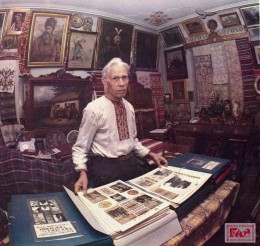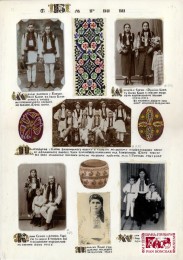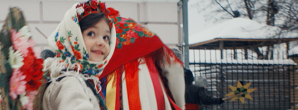-
 About & contacts
About & contacts
-
 Events
Events
-
 Web-project “Ukrainian culture”
Web-project “Ukrainian culture”
-
 Museum’s mission statement
Museum’s mission statement
-
 Exposition
Exposition
-
 Collection
Collection
-
 Ivan Honchar’s library
Ivan Honchar’s library
-
 Typical Ukrainians in the paintings of Ivan Honchar
Typical Ukrainians in the paintings of Ivan Honchar
-
 Ivan Honchar’s picturesque Ukraine
Ivan Honchar’s picturesque Ukraine
-
 Oasis of Ukrainian culture — Ivan Honchar Museum
Oasis of Ukrainian culture — Ivan Honchar Museum
-
 From the Guest book (1962-1988)
From the Guest book (1962-1988)
 Ivan Honchar began working on this now famous album at the end of the 1960s – beginning of the 1970s, and continued until the last day of his life, as a result of which some plates remained unfinished. The author collected material for this album throughout the last four decades of his life. The major part of this work is a collection of old rare photographs, as well as reproductions of unique photographs from various regions of Ukraine (typical local landscapes and people, architecture and material culture, customs and rituals, notable individuals of culture and scholarship, and others). These were diligently arranged on large sheets, 300 x 415 mm, with detailed notes in ink: who is in the photograph, where and when. The plate also included artistic ornamentation in watercolours: traditional folk motifs, examples of local pottery, ceramic tiles, embroidered rushnyky (ritual cloths), woven kylyms, handcarved “bozhnytsia” (shelf for icons), wooden hope chests hand-painted in folk motifs, pysanky (Ukrainian Easter eggs), old folk musical instruments, and others. Every caption, as well as the name of the plate, began with an initial – a letter in the artistic rendering of the author, which brought the album closer to ancient Ukrainian manuscripts. For the most part, Ivan Honchar decorated the plates with drawings of his own artifacts and, sometimes, with that desired wished-for object that he had been unable to acquire for his private museum. In his epistolary life’s work, he clearly indicated that he considered his work on Ukraine and Ukrainians to be of utmost priority, and devoted himself to its completion.
Ivan Honchar began working on this now famous album at the end of the 1960s – beginning of the 1970s, and continued until the last day of his life, as a result of which some plates remained unfinished. The author collected material for this album throughout the last four decades of his life. The major part of this work is a collection of old rare photographs, as well as reproductions of unique photographs from various regions of Ukraine (typical local landscapes and people, architecture and material culture, customs and rituals, notable individuals of culture and scholarship, and others). These were diligently arranged on large sheets, 300 x 415 mm, with detailed notes in ink: who is in the photograph, where and when. The plate also included artistic ornamentation in watercolours: traditional folk motifs, examples of local pottery, ceramic tiles, embroidered rushnyky (ritual cloths), woven kylyms, handcarved “bozhnytsia” (shelf for icons), wooden hope chests hand-painted in folk motifs, pysanky (Ukrainian Easter eggs), old folk musical instruments, and others. Every caption, as well as the name of the plate, began with an initial – a letter in the artistic rendering of the author, which brought the album closer to ancient Ukrainian manuscripts. For the most part, Ivan Honchar decorated the plates with drawings of his own artifacts and, sometimes, with that desired wished-for object that he had been unable to acquire for his private museum. In his epistolary life’s work, he clearly indicated that he considered his work on Ukraine and Ukrainians to be of utmost priority, and devoted himself to its completion.
The author was not able to ornament and complete all the plates in the album. Sometimes, because of the tense pace of his life, he left out certain descriptions in the notes on particular sheets, and in other instances erred in the dating or attribution of certain photographs. Obviously, in the future this grand and lavish work will require a full editing and review.
Ivan Makarovych Honchar arranged the 18 volumes of this album according to the historic and ethnographic regions which he preferred and considered to be the most appropriate: 1. General, vol. 1, part 1 (55 plates); 2. General, vol. 1, part 2 (30 plates); 3. Kyiv and its outskirts (90 plates); 4. Kyiv Province, Right Bank (116 plates); 5. Kyiv Province, Left Bank (115 plates); 6. Northern Kyiv Province (98 plates); 7. Western Kyiv Province (46 plates); 8. Cherkasy Province (123 plates); 9. Poltava Province (82 plates); 10. Slobozhanshchyna – [historic Kozak region of northeastern Ukraine]  (84 plates); 11. Zaporizhzhia Province (20 plates); 12. Chernihiv Province (113 plates); 13. Volyn’ Region: Zhytomyr and Rivne Provinces (90 plates); 14. Podillia [west-central Ukraine]: Vinnytsia and Khmel’nyts’kyi Provinces (100 plates); 15. Halychyna [Galicia]: L’viv, Ivano-Frankivs’ke, and Ternopil’ regions (128 plates); 16. Bukovyna (23 plates); 17. Kozak territory [central Ukraine] (65 plates); 18. incomplete volume (122 plates). The enormous size of the album – 1500 plates – is an indication of the importance of this work. It is known that the author had planned to increase the album to 50, and possibly even 100 volumes, because it was in this breadth that he envisioned a comprehensive illustrated encyclopedia of the Ukrainian nation, where would be documented the historical and cultural attributes of various Ukrainian villages and cities, which were so quickly disappearing during his lifetime.
(84 plates); 11. Zaporizhzhia Province (20 plates); 12. Chernihiv Province (113 plates); 13. Volyn’ Region: Zhytomyr and Rivne Provinces (90 plates); 14. Podillia [west-central Ukraine]: Vinnytsia and Khmel’nyts’kyi Provinces (100 plates); 15. Halychyna [Galicia]: L’viv, Ivano-Frankivs’ke, and Ternopil’ regions (128 plates); 16. Bukovyna (23 plates); 17. Kozak territory [central Ukraine] (65 plates); 18. incomplete volume (122 plates). The enormous size of the album – 1500 plates – is an indication of the importance of this work. It is known that the author had planned to increase the album to 50, and possibly even 100 volumes, because it was in this breadth that he envisioned a comprehensive illustrated encyclopedia of the Ukrainian nation, where would be documented the historical and cultural attributes of various Ukrainian villages and cities, which were so quickly disappearing during his lifetime.
It is interesting that many visitors to the Ivan M. Honchar Museum find on exhibit the photographs of their families and villagers, or friends. Each plate is a miniature artistic treasure of a particular place, with its traditions and typical individuals. In contrast to the contemporary – at the time – national museum fonds and archives, the Ukraine and Ukrainians album was always available to the community. Thus, it was perfectly natural that, given the political climate, despite discussions about its publication with Ukrainian government and diaspora publishers in the early 1990s, nothing happened.
Only in 2006, in the 15th year of independence, Ukraine and its citizens honoured the 95th anniversary of the birth of Ivan Honchar with a selected volume Ukraine and Ukrainians, the plates chosen from various volumes (with the exception of the incomplete volumes 2, 7, 20). With the support of “Oranta” Publishers, the Ukrainian Centre of Folk Culture “Ivan Honchar Museum” begins its national collective working bee with the publication of this work, with the aim of propagating this unsurpassed cultural achievement. The hope is that the 160 plates in this album will go forth into the world as documentary evidence of the historic and cultural distinction and identity of the Ukrainian people, and as individual, still unread pages of human survival from a true chronicle of Ukrainian life.
Ihor POSHYVAILO,
Ethnologist, Ph.D. (in History),
Research Director of Ivan Honchar Museum
























